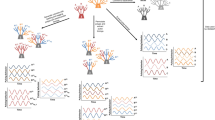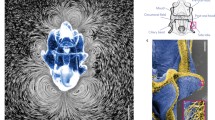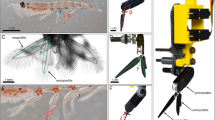Abstract
Coordinated movements have been shown to enhance the speed or efficiency of swimming, flying, and pumping in many organisms. Coordinated pulsing has not been observed in many cnidarians (jellyfish, anemones, corals), as is the case for the xeniid corals considered in our corresponding paper. This observation opens the question as to whether xeniid corals, and cnidarians in general, do not coordinate their pulsing behavior for lack of a hydrodynamic advantage or for other reasons. For example, a diffuse nervous system with lack of substantial sensory input may not be capable of such coordination. Similarly, grouping may serve a defensive role rather than a fluid dynamic role. In this paper, the immersed boundary method is used to quantify the volumetric flux of fluid generated by an individual xeniid coral polyp in comparison with a pair of polyps. Both the distances between the polyps and the phase difference between each polyp are considered. More specifically, the fully coupled fluid-structure interaction problem of a coral polyp driving fluid flow is solved using a hybrid version of the immersed boundary method where the Navier–Stokes equations are solved using a finite differences and the elasticity equations describing the coral are solved using finite elements. We explore three possible hypotheses: (1) pulsing in pairs increases upward flow above the polyps and is thus beneficial, (2) these benefits vary with the polyps’ pulsing phase difference, and (3) these benefits vary with the distance between the polyps. We find that there is no substantial hydrodynamic advantage to pulsing in a pair for any phase difference. The volumetric flux of fluid generated by each coral also decreases as the distance between polyps is decreased. This surprising result is consistent with measurements taken from another cnidarian with similar behavior, the upside down jellyfish, in which each medusa drives less flow when in a group.









Similar content being viewed by others
References
Alben S, Spears K, Garth S, Murphy D, Yen J (2010) Coordination of multiple appendages in drag-based swimming. J R Soc Interface 7:1545–1557
Alben S, Miller LA, Peng J (2013) Efficient kinematics for jet-propelled swimming. J Fluid Mech 733:100–133
Battista NA, Lane AN, Miller LA (2017) On the dynamic suction pumping of blood cells in tubular hearts. In: Layton A, Miller LA (eds) Women in mathematical biology: research collaboration, vol 8. Springer, New York, pp 211–231
Battista NA, Lane AN, Liu J, Miller LA (2017) Fluid dynamics in heart development: effects of hematocrit and trabeculation. Math Med Biol 56:894
Bergmann M, Iollo A (2011) Modeling and simulation of fish-like swimming. J Comput Phys 230:329–348
Colin JHCSP, Gemmell BJ, Dabiri JO, Sutherland KR (2015) Multi-jet propulsion organized by clonal development in a colonial siphonophore. Nat Commun 6:5698
Couzin ID, James R, Mawdsley D, Croft DP, Krause J (2007) Social organization and information transfer in schooling fishes. Wiley, New York, pp 166–185
Croft DP, James R, Ward ea AJW (2005) Assortative interactions and social networks in fish. Oecologia. 143
Dombrowski T, Jones SK, Katsikis G, Bhalla APS, Griffith BE, Klotsa D (2019) Transition in swimming direction in a model self-propelled inertial swimmer. Phys Rev Fluids 4:021101
Durieux DM, Clos KTD, Gemmell BJ (2019) Aggregation and Benthic Locomotion in Upside-down Jellyfish: Impacts on Feeding and Defense. 2019 Annual Meeting of the Society for Integrative Biology. Available from: http://69.36.180.54/meetings/2019
Gazzola M, Chatelain P, Rees WMV, Koumoutsakos P (2011) Simulations of single and multiple swimmers with non-divergence free deforming geometries. J Comput Phys 230:7093–7114
Gravish N, Peters JM, Combes SA, Wood RJ (2015) Collective flow enhancement by tandem flapping wings. Phys Rev Lett 115:188101
Griffith BE, Luo X (2017) Hybrid finite difference/finite element version of the immersed boundary method. Int J Numer Methods Eng 33:e2888
Griffith BE, Patankar NA (2020) Immersed methods for fluid-structure interaction. Annu Rev Fluid Mech 52(1):896
Griffith BE, Luo X, McQueen DM, Peskin CS (2009) Simulating the fluid dynamics of natural and prosthetic heart valves using the immersed boundary method. Int J Appl Mech 1:137–177
Hemelrijk C, Reid D, Hildenbrandt H, J Padding J (2015) The increased efficiency of fish swimming in a school. Fish 16:511–521
Hoover AP, Miller LA (2015) A numerical study of the benefits of driving jellyfish bells at their natural frequency. J Theor Biol 374:13–25
Hoover AP, Griffith BE, Miller LA (2017) Quantifying performance in the medusan mechanospace with an actively swimming three-dimensional jellyfish model. J Fluid Mech 813:1112–1155
Jolles JW, Boogert NJ, Sridhar VH, Couzin ID, Manica A (2017) Consistent individual differences drive collective behavior and group functioning of schooling fish. Curr Biol 27:2862–2868
Jones SK, Laurenza R, Hedrick TL, Griffith BE, Miller LA (2015) Lift- vs. drag-based mechanisms for vertical force production in the smallest flying insects. J Theor Biol 384:105–120
Kremien M, Shavit U, Mass T, Genin A (2013) Benefit of pulsation in soft corals. Proc Nat Acad Sci USA 110:8978–8983
Liao JC (2007) A review of fish swimming mechanics and behaviour in altered flows. Phil Trans R Soc B 362:1973–1993
Liao JC, Beal DN, Lauder GV, Triantafyllou MS (2003) Fish exploiting vortices decrease muscle activity. Science 302:1566–1569
Lissaman PBS, Shollenberger CA (1970) Formation flight of birds. Science 168(3934):1003–1005
Mackie GO (1964) Analysis of locomotion in a siphonophore colony. Proc R Soc B. 159:366–391
Miller LA, Peskin CS (2009) A computational fluid dynamics of clap and fling in the smallest insects. J Exp Biol 208:3076–3090
Park SG, Sung HJ (2016) Vortex interaction between two tandem flexible propulsors with a paddling-based locomotion. J Fluid Mech 793:612–632
Partridge BL, Pitcher TJ (1979) Evidence against a hydrodynamic function for fish schools. Nature 279:418–419
Patel NK, Bhalla APS, Patankar NA (2018) A new constraint-based formulation for hydrodynamically resolved computational neuromechanics of swimming animals. J Comput Phys 375:684–716
Peskin CS (1972) Flow patterns around heart valves: a numerical method. J Comput Phys 10:252–271
Peskin CS (2002) The immersed boundary method. Acta Numer 11:479–517
Peskin CS, McQueen DM (1996) Fluid dynamics of the heart and its valves. In: Adler FR, Lewis MA, Dalton JC (eds) Case studies in mathematical modeling: ecology, physiology, and cell biology. Prentice-Hall, New Jersey, pp 309–338
Portugal SJ, Hubel TY, Fritz J, Heese S, Trobe D, Voelkl B et al (2014) Upwash exploitation and downwash avoidance by flap phasing in ibis formation flight. Nature 505:1399
Samson JE, Ray DD, Porfiri M, Miller LA, Garnier SJ. Collective pulsing in xeniid corals. Part I: Using computer vision and information theory to search for coordination;
Samson JE, Battista NA, Khatri S, Miller LA (2017) Pulsing corals: a story of scale and mixing. Biomath 6:1712169
Samson JE, Miller LA, Ray D, Holzman R, Shavit U, Khatri S (2019) A novel mechanism of mixing by pulsing corals. J Exp Biol 222(15):56
Santhanakrishnan A, Jones SK, Dickson WB, Peek M, Kasoju VT, Dickinson MH et al (2018) Flow structure and force generation on flapping wings at low reynolds numbers relevant to the flight of tiny insects. Fluids 3(3):5968
Sutherland KR, Weihs D (2017) Hydrodynamic advantages of swimming by salp chains. J R Soc Interface 14:20170298
Swain DT, Couzin ID, Leonard NE (2015) Coordinated speed oscillations in schooling killifish enrich social communication. Curr Biol 25:1077–1109
Taylor ZJ, Gurka R, Kopp GA, Liberzon A (2010) Long-duration time-resolved PIV to study unsteady aerodynamics. IEEE Trans Instrum Meas 59(12):3262–3269
Triantafyllou MS, Triantafyllou GS, Yue DKP (2000) Hydrodynamics of fishlike swimming. Annu Rev Fluid Mech 32:33–53
Tytell ED, Hsu CY, Fauci LJ (2014) The role of mechanical resonance in the neural control of swimming in fishes. Zoology 117:48–56
Zhang C, Guy RD, Mulloney B, Zhang Q, Lewis TJ (2014) Neural mechanism of optimal limb coordination in crustacean swimming. Proc Nat Acad Sci USA 111:13840–13845
https://photron.com/software-downloads/ (Accessed on 7 Nov 2017)
Acknowledgements
The authors would like to thank Boyce Griffith for the development of IBAMR, Roi Holzman and Uri Shavit for introducing us to pulsing corals and for their assistance with PIV, Shilpa Khatri for development and testing of the model and PIV, and the members of the Miller Lab who helped take care of the pulsing corals.
Funding
This work was supported by NSF PHY Grant #1504777 (to LAM) and the DFG Centre of Excellence 2117 “Centre for the Advanced Study of Collective Behaviour” (ID: 422037984). During this project, JES was supported by a Howard Hughes Medical Institute International Student Research Fellowship.
Author information
Authors and Affiliations
Corresponding author
Ethics declarations
Conflict of interest
All authors have declare that they have no conflict of interest.
Additional information
Publisher's Note
Springer Nature remains neutral with regard to jurisdictional claims in published maps and institutional affiliations.
Rights and permissions
About this article
Cite this article
Samson, J.E., Miller, L.A. Collective Pulsing in Xeniid Corals: Part II—Using Computational Fluid Dynamics to Determine if There are Benefits to Coordinated Pulsing. Bull Math Biol 82, 67 (2020). https://doi.org/10.1007/s11538-020-00741-y
Received:
Accepted:
Published:
DOI: https://doi.org/10.1007/s11538-020-00741-y




